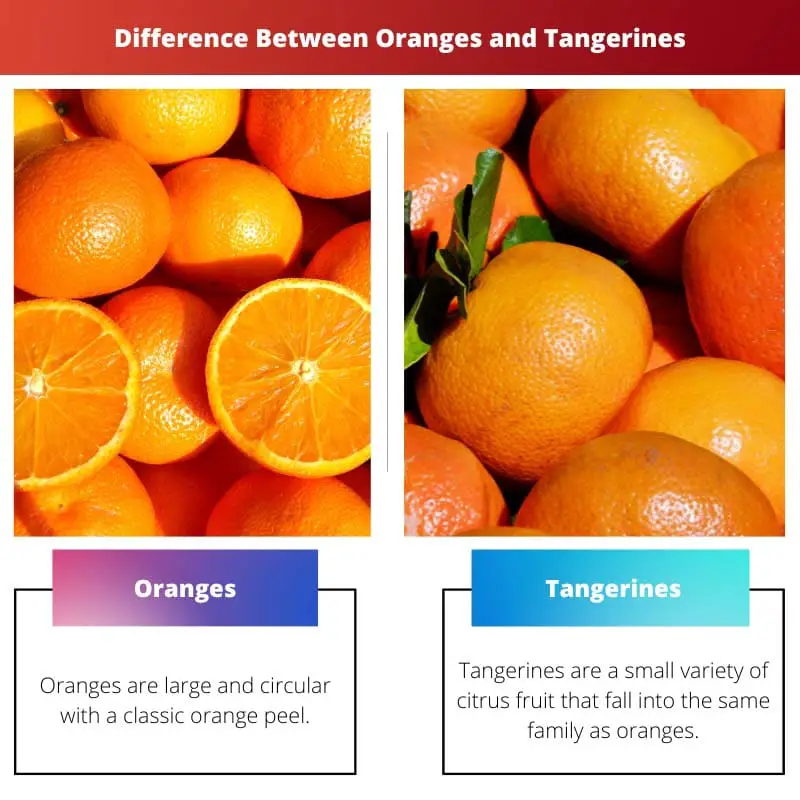Oranges and tangerines are citrus fruits that are the primary source of vitamin C and have many health benefits. People tend to be confused between both.
This is because they are very similar in size and color. They differ in the nutritional content that each of the fruits holds. Despite all the differences, they belong to the same category of fruits.
Key Takeaways
- Oranges are larger, with thicker skin and more seeds, while tangerines are smaller, with thinner skin and fewer seeds.
- Tangerines have a sweeter taste and are easier to peel than oranges, making them more convenient for snacking.
- Oranges contain more vitamin C and fiber than tangerines but have a similar overall nutritional profile.
Oranges vs Tangerines
Oranges are one of the most famous fruits in the world, and they’re under the citrus family, which is low in calories and very nutritious. Tangerines are citrus fruits that are filled with different minerals and are a good source of vitamin A, which is completely beneficial to the human body.

Oranges are large and circular with a classic orange peel. The color of the peel might differ depending on the quality of production and also the season during which it is in the markets.
But it would always be a different shade of orange, lighter or darker. Oranges are firm when ripe but would be soft when they become overripe and close to decay.
Tangerines are a small variety of citrus fruit that fall into the same family as oranges. The peel is a darker shade of orange with many ditches and crevices.
Tangerines are a bit soft to touch once the fruit completely ripens, and there are exceptions where there might be tinges of green on the peel even after being ripe.
Comparison Table
| Parameters of Comparison | Oranges | Tangerines |
|---|---|---|
| Origin Of Word | Tamil | Morocco |
| Sweetness | Low | More |
| Easy To Peel | No | Yes |
| Many Varieties | Yes | Comparatively less |
| Color | Orange or dark shades of yellow | Deep reddish orange |
What is Oranges?
Oranges belong to the genus of citrus fruits and have the scientific name Citrus X sinensis.
It has a round and circular shape with a firm fruit body.
It is known to have originated from East Asia, more specifically from areas around China and Indonesia.
These places had the optimum weather conditions for the orange trees to grow and give great produce every year.
Now, with the advancement of technology and science, oranges are grown in places like the US and Brazil.
Some believe that mandarins evolved from oranges.
But it is the other way around. This means that oranges evolved from mandarins.
The size of an orange is never uniform as there are many varieties of oranges and the size and color may differ according to the pigments present and the sugar content of each fruit.
Every single orange weighs more than what is expected after it is ripe. It is because the juice and pulp increase after ripening.
But despite the high juice content in oranges, they are still quite firm and hard on the outside.
Oranges could either be seedless or have seeds. It depends on the variety of orange.
Because they are seedless, Navel oranges are known for their ease of consumption.
On the other hand, Valencia oranges are the more common ones we see and have seeds.
Oranges are sour due to the presence of vitamin C.
But they have slight tinges of sweetness.
An exception to this is blood oranges, which are not just slightly sweet and sour, but has a berry-like taste that makes them exotic and sought after.
The peel of oranges is thin, but it is difficult to peel. Therefore, people only cut oranges instead of trying to peel them.
Most of the nutritional content in oranges is in water, and it is the main constituent in oranges.
There are carbohydrates, fibers, and potassium in high quantities. The fat content is almost nil.
One main health benefit of oranges is that having oranges can help reduce any possible DNA mutation or damage.
These kinds of mutations can happen during the lifetime of a person.
It also helps reduce “LDL” cholesterol levels in the body and therefore reduces the risks of congested arteries and blood vessels.

What is Tangerines?
Tangerines belong to the group of fruits in the genus Citrus and have the scientific name Citrus reticulata.
Tangerines originated somewhere in Florida, but the name is of Moroccan origin as it is known to be imported from the city of Tangier in Morocco.
Even though they belong to the citrus family, they belong to the species of tangerine. It is what mainly differentiates tangerines from oranges.
People tend to confuse tangerines with mandarins. But in reality, mandarins are a different species of citrus fruit, similar to oranges.
It is from mandarins that tangerines have evolved.
The size of tangerines is small, an irregular circle, and can even fit in the hands of a small child.
Due to its size and many similarities to oranges, it is also called “baby oranges”.
It is also a bit flat in shape, and the peel has many crevices and pits on the surface.
It is easier to carry around a tangerine in a pocket and have it as a pocket snack.
Tangerines are primarily filled with seeds. But with the help of genetic engineering, new and seedless tangerine varieties are now available on the market.
The color of tangerines is reddish-orange or slightly yellow, depending on the quality and the ripeness of the fruit.
Tangerines are sweet and not as sour as most other mandarin varieties.
Even though the peel of tangerines is thin, it is really easy to peel off and, due to this, the peel of tangerines is also called zipper-skin.
There is the high water content in all tangerines and a low carbohydrate quantity with no amount of fat present in them.
Other nutritional constituents include vitamin A, potassium, thiamine, etc.
Tangerines have many health benefits, such as weight loss and a lower risk of heart failure.

Main Differences Between Oranges and Tangerines
- Oranges are round and almost perfectly circular, whereas tangerines are more flattened while being round at the same time.
- The peel of an orange is smooth with few crevices and pits in it, whereas the peel of tangerines is not smooth and is quite rough with many small crevices.
- Oranges are very firm even after being ripened, whereas tangerines are soft to the touch and will become softer with time.
- The acidity of pH is higher for oranges due to their larger size, whereas tangerines have a lower pH.
- Oranges are present in nature both with and without seeds, whereas tangerines are present only with seeds. But now, with the help of technology, seedless tangerines are also being produced.

- https://www.sciencedirect.com/science/article/pii/S0168952501024428
- https://www.sciencedirect.com/science/article/pii/S0889157505001432
